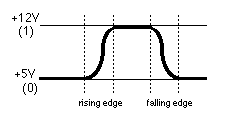|
Flip-flops are designed to change the value they store during the brief interval of time when the voltage is changing from one level to another. This time, called either the rising edge or the falling edge, depending upon the two plateaus on either side, is always much shorter than the level period in between, hence flip-flops are more reliable. Level-triggered devices, latches, have a much longer time during which to change their state and hence are more sensitive to fluctuations. Fig. 5.4.5 shows the two different edge times: Any particular flip-flop is designed to change the value stored either on the falling edge or the rising edge, but not both. Hardware designers can select whichever type is most convenient. The flip-flop of Fig. 5.4.2 changes state on the falling edge. |
